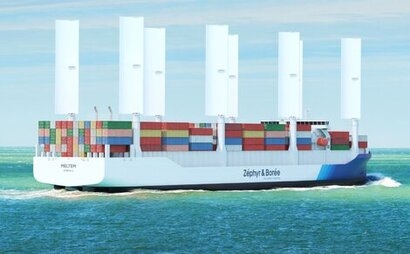
The 185 metre-long container vessel is designed with five cargo holds, mostly open-top. Propulsion means are compliant with IMO’s Tier III requirements, and the vessel is equipped with shaft generators and a heat recovery system that minimises fuel consumption. The vessel’s propulsion system will be assisted by eight sails provided by CWS (Computed Wing Sails). The design is a thick, asymmetrical wing-sail that can be steered to catch port and starboard winds, and adjusts itself automatically depending on the wind conditions to ensure optimal savings.
In the race to decarbonise their fleet, many shipowners are researching alternative propulsion methods as a way to improve the energy efficiency of their vessels and reduce their emissions. Among emerging options, wind-assisted propulsion is considered a strong contender for achieving significant emissions reduction, using a free, clean and renewable energy source available worldwide.
BV was involved from the very early stage of the design. The main design principles were reviewed in order to ensure the feasibility of the concept and identify any obstacles. The AiP confirms the design’s compliance with the most recent BV notations, including NR 206 on Wind Propulsion systems.
“We are convinced that the wind energy will play an important role in the years to come to decarbonise ships’ propulsion” said Nils Joyeux, CEO at Zéphyr & Borée. “The integration of sails on container ships is an important technical challenge on which we are working hard at Zéphyr & Borée. We are delighted to collaborate with BV on this project, which represents a key milestone by demonstrating the viability of wing-sails as a wind propulsion solution for container ships. We intend to continue our work with maritime stakeholders to offer wind propulsion solutions that are economically viable and make a tangible difference for the sector.”
Laurent Leblanc, Senior Vice President Technical & Operations at Bureau Veritas Marine & Offshore, added that wind, even if it is not always available, is a serious option to help decarbonise the shipping industry and that wind propulsion systems can play a significant role by providing substantial propulsive energy.
“With this AiP, we are pleased to demonstrate the technology can be applied to containerships, which represent 17.5 percent of the global fleet (in tonnage)” said Mr Leblanc. “Bureau Veritas continues to lead the way in developing guidelines and frameworks for the safe and efficient use of this promising technology.”
To help clients move forward with wind-assisted propulsion, Bureau Veritas has released classification rules that provide a framework for wind propulsion systems (WPS). These rules address safety and reliability from the design review stage through installation and operations, including survey regimes and maintenance requirements. To comply with WPS rules, ships must undergo a risk analysis, determine local and general ship strength, and define load cases, automation and release systems.
For additional information:

